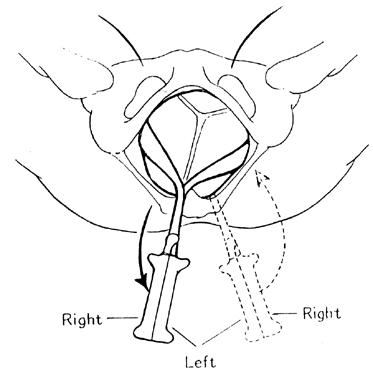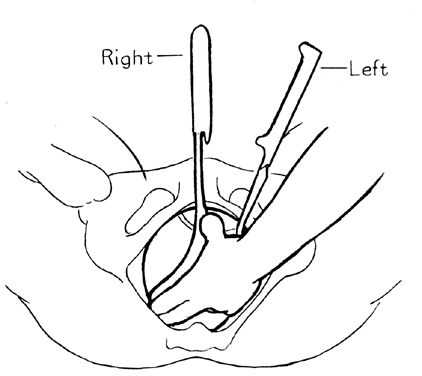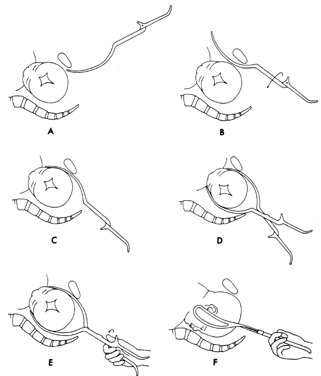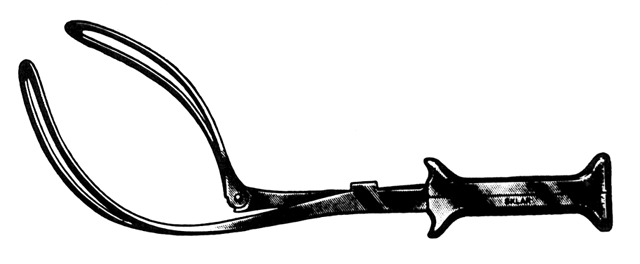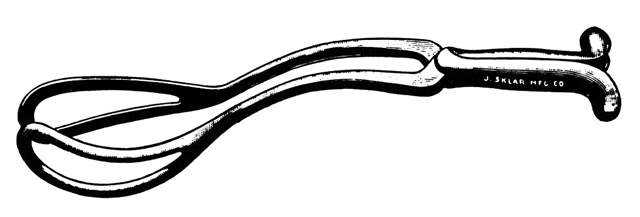The era of modern operative obstetrics began with the invention of the forceps (Fig. 1) by Peter Chamberlen, Sr. Subsequently, over the years the ability to use forceps separated the obstetricians from the midwives. The use of forceps reached its acme in the United States as a result of the influence of DeLee, who in 1920 taught the importance of prophylactic forceps and episiotomy to protect against maternal and fetal injury.
|
Dennen1 emphasized the importance of knowledge about and training in the use of forceps:
Detailed instruction in the use of the various types of obstetrical forceps is difficult to obtain. . . . A thorough knowledge of the advantages and disadvantages of the various types of forceps, and the techniques of their use will eliminate many of the bad results following blind faith in one type, or the “trial and error method.” . . . A properly chosen and well-executed forceps delivery does not increase the risk of a bad result. Nor does the operator, in the average case, have to be one of exceptional skill, provided he has had detailed training in the use of forceps and knows his limitations.
DeLee's teaching was the impetus for the dramatic increase in the number of forceps deliveries performed in the United States from the 1930s through the 1950s. However, due to the provocative studies by Friedman and colleagues2,3,4 and the increasing tendency for an adverse obstetric outcome to result in a malpractice suit, obstetric forceps delivery rates have fallen in the United States. In 1968 in New York City, 29.7% of births were forceps assisted, but by 1978 the incidence was down to 12.2%.5 At the same time, in the United States, cesarean birth rates rose from 5.5% in 1970 to 15.2% in 19785 and now is as high as 20% to 25%.
In an attempt to evaluate the diminishing opportunity for trainee obstetricians to develop skills and knowledge in the techniques of midforceps delivery, Healy and Laufe6 sent questionnaires to 144 US and Canadian members of the Association of Professors of Obstetrics and Gynecology to survey residency training in the use of forceps. They analyzed 105 programs delivering approximately 283,000 women in 1981. All programs used outlet forceps, and all but one used midforceps. Significantly, staff obstetricians were present and instructing in the delivery room only 50% of the time in the United States, but in Canada a staff obstetrician was the principal instructor. Further, the mode of selection of the forceps most commonly used for midforceps and outlet forceps was habit and past experience, rather than design and function. Ironically, the authors of the study pointed out, two major postgraduate obstetrics texts devoted fewer than 2% of their pages to forceps delivery. More recently, Ramin and associates7 surveyed 295 US and Canadian residency programs; of these, 203 responded, representing 458,000 deliveries with results similar to those of Healy and Laufe.6 They did note, however, that institutions that performed midforceps deliveries did not have a decrease in their cesarean section rates. Dennen1 emphasized detailed lectures about forceps, practice with mannequins, and supervision first in easy cases and later in more complicated ones to ensure proper training in the use of forceps.
A vicious cycle of decreased opportunity, poorly supervised procedures, and even lack of detailed instruction in textbooks may lead to a generation of obstetricians who are lacking skills in forceps deliveries and therefore are unable to pass these skills on to the next generation.
Is the abandonment of forceps (especially midforceps) deliveries desirable? The issue is clearly debated in two articles, one by Friedman, who is against it,8 and the other by Hayashi, who is for it.9 Interestingly, both authorities quote many of the same articles to support their opposing points of view. Friedman makes a compelling argument for abandoning midforceps by proposing that failure to prove statistical significance for poor outcomes is not the same as proving that a significant difference does not exist. In contrast, Hayashi made the following statement: “Although the controversy surrounding midforceps deliveries is real, it appears that the bulk of the evidence would support the use of this technique when properly indicated and skillfully applied in the management of labor.”9
While there is little controversy about the use of low or outlet forceps, which are accepted as safe methods for expediting delivery, a major controversy exists over the safety of midforceps operations for both fetus and mother. The problem with studies of midforceps operation has always been and will continue to be one of determining whether or not the operation really is a midforceps one. In an effort to simplify the terminology for forceps procedures and redefine midforceps, the American College of Obstetricians and Gynecologists (ACOG) reclassified forceps deliveries according to station and rotation (Table 1).10
TABLE 1. Classification of Forceps Deliveries According to Station and
Rotation
Type of Procedure | Criteria |
Outlet forceps | 1.Scalp is visible at the introitus without separating labia |
| 2.Fetal skull has reached pelvic floor |
| 3.Sagittal suture is in anteroposterior diameter or right or left occiput |
| anterior or posterior position |
| 4.Fetal head is at or on perineum |
| 5.Rotation does not exceed 45° |
Low forceps | Leading point of fetal skull is at station |
| pelvic floor |
| a.Rotation |
| right occiput posterior to occiput posterior) |
| b.Rotation >45° |
Midforceps | Station above +2 cm but head engaged |
High | Not included in classification |
The reasons for forceps applications may be fetal or maternal. Forceps can be used to correct rotational defects or abnormalities of fetal attitude (deflexions). Often, the two conditions go together and are corrected with appropriate forceps maneuvers. Forceps can also be used to aid maternal expulsive efforts, which may be impeded by exhaustion, sedation, or regional anesthetics. Forceps can be used to expedite deliveries in cases of fetal or maternal needs. A prolonged second stage of labor with prolonged compression of the pelvic floor may cause damage to the pelvic muscular supports and nerves to the pelvic muscles. This damage may be a cause of later difficulties with continence of urine and stool. The proper use of forceps to shorten the prolonged second stage of labor may prevent these long-term disabilities. Forceps should not be used to overcome cephalopelvic disproportions.
Schifrin11 criticized ACOG for making new definitions and changes in forceps delivery classification without support from conclusive data. Hagadorn-Freathy and co-workers,12 however, prospectively studied 357 forceps deliveries, comparing the older classification with the newly recommended classification. Allowing a 45° rotation or less at S + 2 or more did not increase morbidity measured by any criterion. In evaluating midforceps procedures as currently defined, they did find increased morbidity; however, they pointed out that outcomes may reflect the experience of the institution where the study is performed.
Schifrin11 questioned whether the redefinition provides better tabulation of actual practice and really comes through in its promise to diminish the risks of forceps deliveries for mothers and babies. He also indicated that the new classification provides no new data for evaluating the specific impact of midforceps procedures on the prosecution and defense of malpractice litigation. Schifrin correctly pointed out numerous confounding variables that make evaluation of forceps data virtually impossible (Table 2).
TABLE 2. Evaluation of Forceps Data
Confounding Variables | |
Fetus | Anesthesia |
Estimated weight | Type |
Actual weight | Dosage |
FHR pattern | Timing |
Fetal Head | Efficacy |
Engagement | Clinical |
Station | Parity |
Position | Maternal weight/height |
Attitude | Indication |
Molding | Previous pregnancy outcome |
Synclytism | Accuracy |
Pelvis | Experience |
Type | Skill |
Dimensions | Intention |
Forceps | Outcome |
Type | Apgar score, pH/hypoxia |
Rotation | Trauma |
Force | Seizures |
Number of attempts | Handicap |
Labor | Disability |
Duration | Anomaly |
Pattern |
|
Contractions |
|
Pushing |
|
FHR = fetal heart rate.
(Schifrin BS: Polemics in perinatology: Disengaging forceps. J Perinatol 8(3):242, 1988)
I believe Schifrin has correctly identified the problem with classifying any forceps operation. It is quite clear that estimating fetal weight is fraught with error, leading to miscalculations in the difficulty of delivery. Neither clinical experience nor the use of ultrasound seem to have improved estimations of fetal weight. The accurate estimation of the station of the fetal head is probably the most common problem in evaluating a forceps operation. Difficulties with determining position and attitude become complicated by molding and asynclitism. Determining the midstation of the pelvis and defining the station are difficult for less experienced operators. Although the type of pelvis and its dimensions are important in determining the type of forceps and the delivery technique, rarely is this calculated by inexperienced operators. The forceps used should be chosen for their designed function. There are numerous types of forceps, each offering distinct advantages, while others are designed for specific functions. When describing a forceps operation, how can one describe the amount of force utilized? How can one describe the accuracy of the rotational movements of the instruments? How much help can the woman give with her bearing-down efforts? How much of the efforts have been obtunded by the effects of the anesthesia used? How can we compare the outcomes of fetal distress in the second stage of labor delivered by midforceps compared to cesarean section? Finally, how do we assess whether the outcome was the result of delivery technique or preexisting circumstances?
Schifrin appropriately makes the following generalizations:
- Delivery is not a major determinant of neurobehavioral outcome.
- Compared to spontaneous delivery, midforceps carry an increased risk of
trauma and neurobehavioral abnormalities.
- Meticulous technique, limited to carefully selected, clearly indicated
cases should minimize the potential for maternal/fetal damage. Under these
conditions, presumably, midforceps operations may be as safe or safer
for both mother and offspring than Cesarean sections. Comparisons
between deliveries by midforceps with deliveries by Cesarean section, when
controlled for indication (distress, dysfunctional labor, etc.) fail
to support a significant benefit for either.
- The classification of the forceps procedure is less important than the
deliberations on how carefully the case is selected.
- The medically indicated use of forceps does not present prima facie evidence
of malpractice.
- A detailed discussion of the indications, intentions and technique must
be included in the operative note and discussed with the patient beforehand.11
To fulfill these precepts, detailed instruction and supervision of forceps operations by experienced teachers must once more become part of any complete training program in obstetrics. A successful forceps operation does not depend on the technical skill of the operator, but on the operator's judgment and experience. Schifrin11 espoused the concept that defense against litigation requires a reasonable note, which should contain the indication for the forceps, a statement of informed consent, the station of the vertex, the attitude, degree of flexion, the instrument chosen, and the effort needed to complete the operation. Apgar scores, cord blood gases, and a description of any trauma observed should be recorded. These notations, clearly stated at the time of delivery, are the obstetrician's best defense in the event of litigation.

 +2 cm and not on the
+2 cm and not on the 45° (left or right occiput anterior to occiput anterior, or left or
45° (left or right occiput anterior to occiput anterior, or left or














